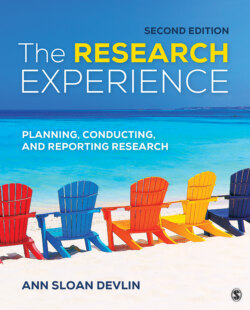Читать книгу The Research Experience - Ann Sloan Devlin - Страница 9
Introduction
ОглавлениеResearch. Many professors view research as the foundation of their discipline, the most important part of what they do. I agree. This book is written with the goal of exciting you about the research process. Many of us believe research methods is the most important course in the social and behavioral sciences, outweighing statistics, which might be viewed as a support system. Statistics are important, but their real value lies in their use to answer research questions.
Despite whether you plan to conduct research as part of a career, knowing the core values of the research process is important for you. Knowing the fundamentals of research design and analysis will not only help you in your education, but it will also make you a more sophisticated consumer of information in your personal and professional life.
Before taking a course in research methods, students provide interesting answers to the question, “What is research?” Some students think doing a Web search constitutes “research” (i.e., looking for articles by a given author); others think writing a literature review is “doing research” (i.e., presenting the existing research). In this book, we take the position that doing research involves (a) the formation of a hypothesis (or statement of purpose in exploratory investigations); (b) the acquisition of data to test that hypothesis or explore relationships (there are many approaches to such data acquisition); (c) evaluation of data or information, typically using inferential statistics; and (d) presentation of a conclusion or summary of findings based on the evidence.
One major hurdle in conducting sound research is avoiding the biases and faulty assumptions that are characteristic of human thought. That is why this book begins with an examination of such biases in thinking. Throughout the book, we will return to this theme of how the way we think influences the choices we make about the research process.
By working through the chapters in this book, you will learn how to do the following:
1 Recognize how biases in thinking are active during the research process
2 Select an area of interest and search the literature to see the published research on that topic
3 Formulate one or more hypotheses based on this literature
4 Design a study based on recommended approaches
5 Select valid and reliable scales to measure your variables of interest
6 Prepare a survey or other instrument to collect your data (using online survey software or a paper-based document)
7 Write a proposal to be evaluated by an ethics board (typically called the Human Subjects Institutional Review Board [IRB])
8 Collect data (using a campus subject pool, a source off campus, or an online source)
9 Create a data file or download your data from survey software
10 Analyze your data using a statistical package such as SPSS Statistics®
11 Understand what your data mean and how to report your results
12 Discuss your findings in the context of your hypotheses and the broader literature
13 Identify the limitations of your research, and propose directions for future research
Finally, you will learn how to write up this research following the guidelines of the Publication Manual of the American Psychological Association (APA, 2020) and avoid common mistakes in writing and style. In addition, you will learn how to prepare your article for publication and decide where to submit it if that is a goal. At the end of this book, you should have the skills to produce a well-executed project and a well-written research report or manuscript.
The skills you have acquired in the process of conducting research will enable you to compete successfully for internships and jobs. Students who have mastered the research process know how to locate measures, how to use survey software such as Qualtrics, how to analyze data using IBM SPSS, and perhaps even how to collect data using a crowdsourcing online tool such as AmazonMTurk®. With these skills, you are well positioned to compete effectively for a variety of jobs.
Each chapter contains three kinds of questions to promote learning: Revisit and Respond; Try This Now; and Build Your Skills. Revisit and Respond items generally ask directly about the information in the chapter (e.g., explain why or list two examples of …) and would be considered review questions. Try This Now questions ask you to pause and stretch a bit to go beyond the information given at the moment (e.g., after reading the list, come up with three additional settings where you think ethnographic research could be conducted; see Chapter 6). Build Your Skills items at the end of the chapter are either questions or activities that ask you to apply what you have learned to some of the major issues in the chapter. For example, you might be asked to make a case for having institutional review board (IRB) review (see Chapter 4) even for projects with no more than minimal risk or to create an account to try out a free version of an online survey software (see Chapter 5).
